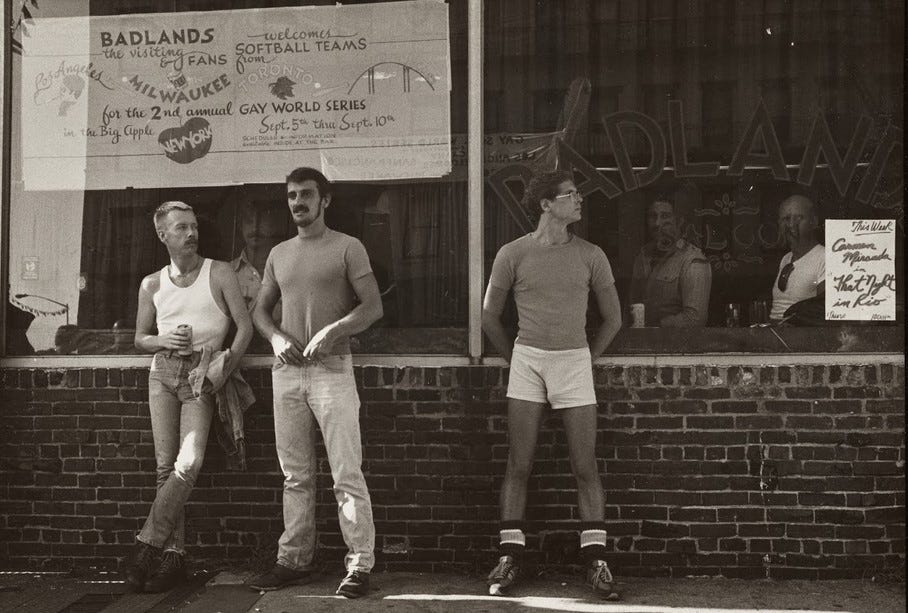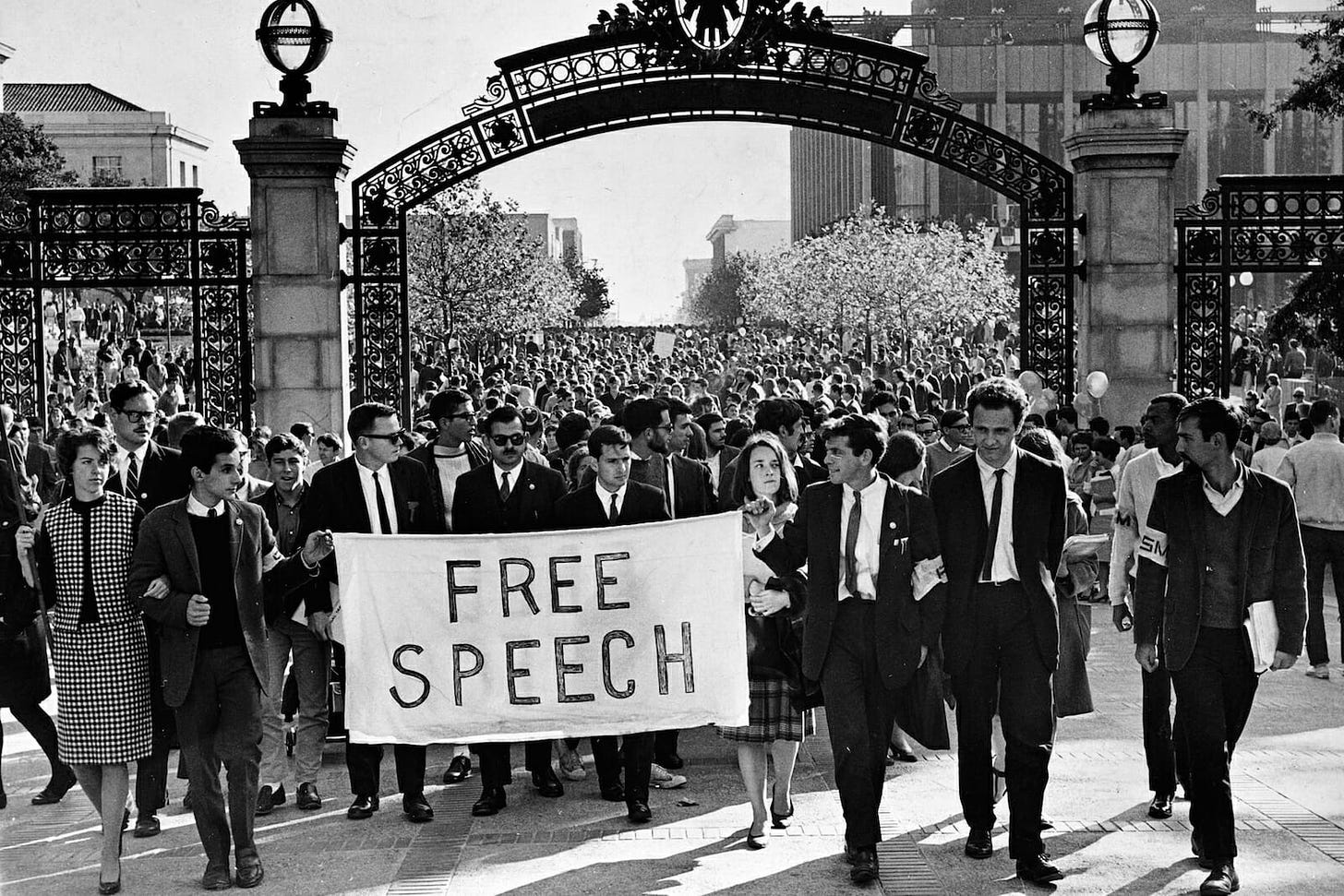The Early Days of HIV/AIDS - Setting the Stage: 1969-75
The Sexual Revolution Begets Gay Liberation, Rise of Urban Gay Culture, Laissez-Faire Sexual Marketplace, and "Freedom at Last!"
Bar Patrons in Front of Badlands Bar and Gay World Series Banner (from the Leonard Fink Collection)
Previous Entry - Introduction
This story begins with “The Pill”.
In 1960, the FDA approved the first oral contraceptive, Enovid, for the US market. Despite its approval, it faced all sorts of legal obstacles and challenges, taking another 12 years before becoming universally available throughout the country thanks to the Supreme Court ruling in Eisenstadt vs. Baird. By 1972, the result was already a foregone conclusion thanks to the rapid liberalization of US culture and politics over the previous several years. A more important date was 1965, the year in which the Supreme Court ruled that married couples have the right to use birth control (Griswold vs. Connecticut). This is the key date in the Sexual Revolution, its Bastille Day.
The introduction of The Pill removed sex from the act of procreation. For the first time in the history of mankind, consensual heterosexual sex (or even coercive, if the female was already on contraceptives) was divorced from the possibility of pregnancy resulting from it. This freed women from the fear of an unwanted pregnancy and all the social and economic constraints attached to motherhood. Not only that, it meant that she could freely engage in sex strictly in pursuit of physical pleasure.
The breaking of this bond thanks to science and medicine was indeed revolutionary. Women could now put off pregnancy to chase their own goals on their own timetables, granting the men that they chose to have sex with the peace of mind that came with the knowledge that they weren’t going to “knock her up”. This new freedom also opened up the opportunity for women to pursue their own rights. Post-war Feminism was turbo-charged by The Pill.
Heterosexual sex, now divorced from procreation, could launch itself head-first into the open sea of sexual pleasure for the sake of pleasure and pleasure alone. No-strings attached sex. “If it feels good, do it.” Epicureanism had finally found its moment-in-the-sun, with Hedonism standing in line next to it.
This wasn’t the only current of ‘freedom’ that was flowing through America at the time. To trot out the most tired of clichés, the 1960s was truly a time of radical change. White liberals joined Blacks to push for their civil rights and for de-segregation as well. Women began to re-assess their roles in society, with many opting for feminism and women’s rights (receiving key assistance from philanthropic organizations like the Ford Foundation). Campus radicals like Mario Savio launched movements that would find fertile soil later in the decade as the USA escalated its war in Vietnam, one that involved drafting ordinary American men to fight in a tiny country half way on the other side of the planet. The antiwar movement crystallized opposition to conservative America, resulting in both systemic and non-systemic (including terrorist groups like the Weather Underground) opposition to the government.
Others chose a different route; dropping out of society altogether. Some of these were known as Hippies, and they would turn to drugs like LSD in order to find hidden truths that would allow them to live their lives to be more in tune with Mother Nature. “Turn on, tune in, drop out” was their motto, coined by Harvard Psychologist and LSD Evangelist, Timothy Leary. These were the ascetics of their time.
When you combine all of these movements together, a very clear and obvious conclusion stares you right in the face: this was a rebellion against the culture and mores of 1950s America. Whether as a rejection of “bourgeois values”, or escape from “all-consuming Christian moralism”, etc., this growing youth cohort (known as “The Boomers”) took one look at their parents lives and said “no”. “Stifling” social roles and expectations were viewed as too confining and “uncool”. The “rage against the bedtime” during the Eisenhower Era gave way to the unbridled quest for personal liberty and freedom a decade later when these same Boomers began to enter adulthood.
This liberalization of American youth culture did not spread instantaneously across the country, but instead was limited to certain geographies during the 1960s, mainly a handful of university campuses, or in states like California, and cities like New York. Most high school boys in 1968 were still sporting buzzcuts, for example. It wasn’t until the next decade that this cultural liberalization managed to conquer the country as a whole (see this 2000 book by David Frum). But the seeds were planted in the 1960s and began to sprout in these localities, capturing certain cultural, academic, and even political elites who resided there. Freedom was now on the menu, and “free love” aka no-strings sex, was the dessert special.
It was the actual size of the Boomer cohort in terms of population that gave them their cultural cache, amplified by the spread of television and the rising popularity of rock’n’roll. Youth culture was now central to American culture as a whole, assigning to them not just economic power (thanks to a booming pre-post-industrialized US economy that dominated global trade due to lack of competition abroad), but political power as well. This meant that the youth were now being actively courted by politicians, and were influencing those very same politicians as well. These White liberals insisted on equality between the sexes, and between the races, so that the country could finally deliver the freedoms promised to all Americans once and for all.
Gay Rights and Stonewall
If heterosexuals could partake in the Sexual Revolution as a form of liberation from both the rejected bourgeois values of the Eisenhower Era and the threat of pregnancy, then why shouldn’t homosexuals have the same right? Removing the possibility of procreation in heterosexual sex by way of The Pill served to bring heterosexual sex closer to homosexual sex, as the latter never had anything to do with procreation, and was instead wholly pleasure-based (when outside of rape). Consistency required that they too should be free to engage in consensual sexual activity just like heterosexuals. Therefore, Gay Liberation joined the ranks of Black Civil Rights and the Women’s Rights movement as part of the package that sought to redefine American culture going into the 1970s.
Up until that point in time, gay life was very repressive in the USA. Criminalized in most US states (Illinois in 1962 was the first state to decriminalize homosexual relations), the life of a gay man was one of being “in the closet” out of fear of losing one’s job if their homosexuality were uncovered, or due to fear of physical violence from others. Places where they congregated (such as bars, public parks, and public washrooms) were routinely raided by police officers. Many of these raids would be the result of vice cops going undercover and often entrapping these gay men looking for sex. Oftentimes, these men would be beaten, and then named and shamed in local media.
It was through this sexual networks that gay men would learn about “gay ghettoes” that were sprouting up in certain neighbourhoods in cities like New York, San Francisco, Chicago, Los Angeles, and elsewhere. These places began to act as a magnet for gay men, attracting them from all over the country, freeing them from the restrictive culture that confined them to the closet, transplanting them to communities that embraced them and their sexuality. They had found their people in these gay villages, and with it came the freedom denied to them elsewhere.





